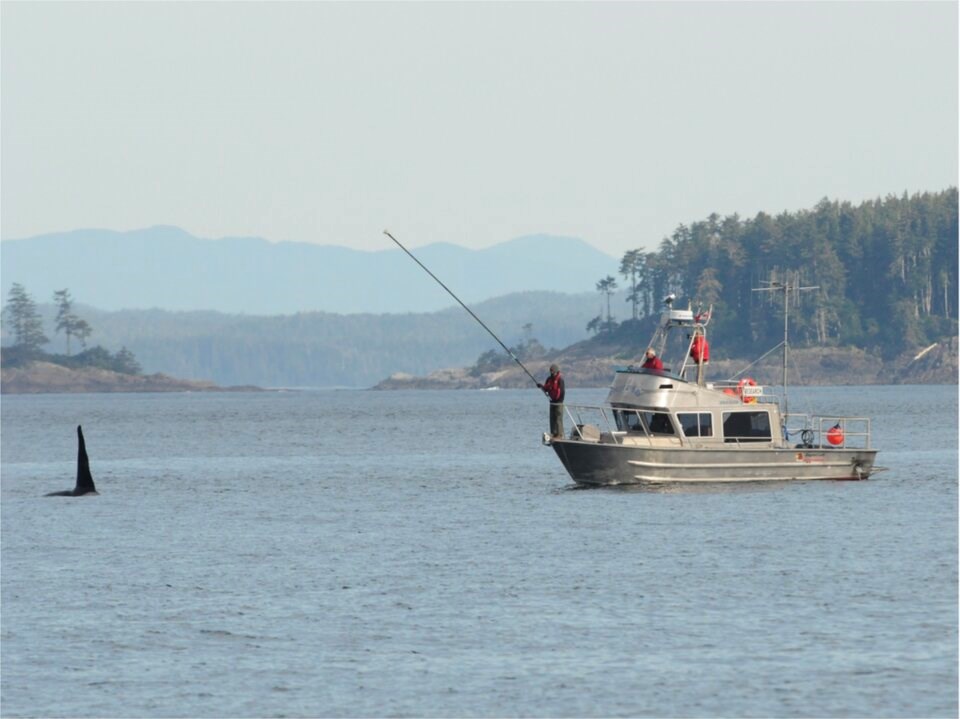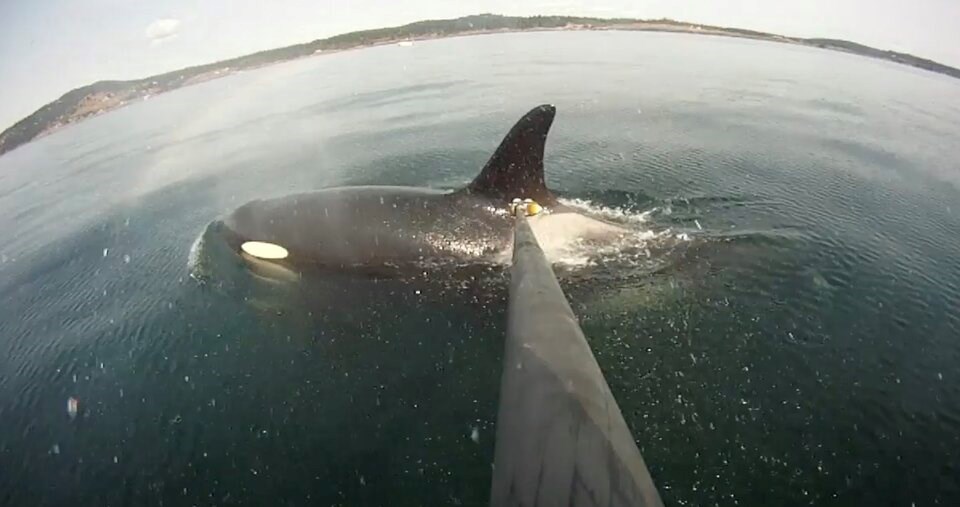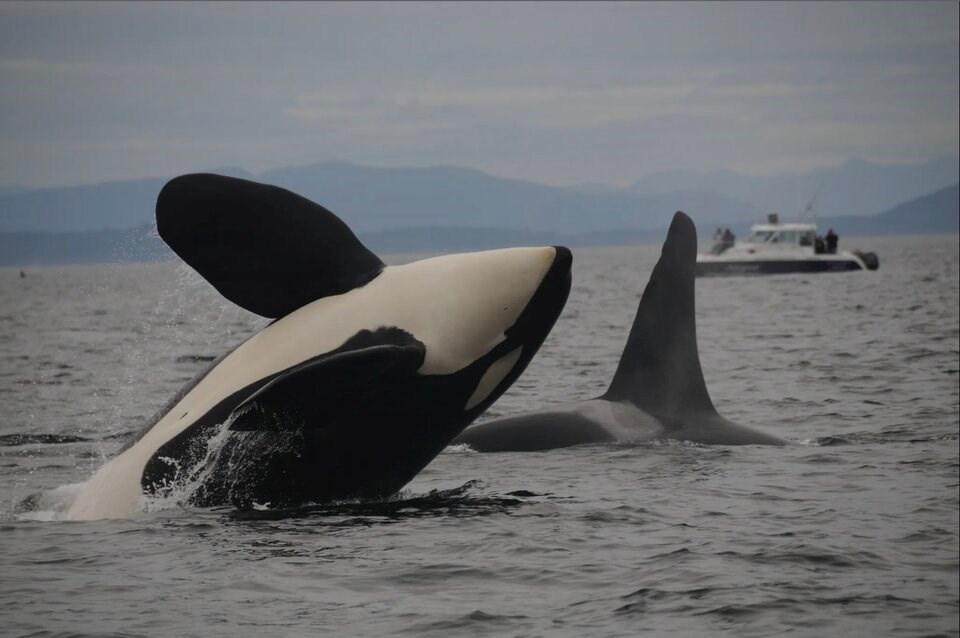Sam Burich and Joe Bauer had spent a week on Saturna Island’s East Light Point waiting for the right moment. On July 16, 1964, they saw it — as the killer whale family J Pod approached the shore, Burich fired a harpoon into the skin of a “20-foot bull killer, a voracious prowler of the north Pacific,” as The Province newspaper put it the next day.
Burich, a sculptor looking for a model to shape a replica statue outside the Vancouver Aquarium, and Bauer, his assistant, jumped in their boat as the whale ran out 200 metres of line attached to buoys.
The pair tied the rope to the stern of the boat, led the animal in circles, and “pumped rifle shells into the mammal” to slow it down, according to the account. Miraculously, the five-year-old whale survived the attack. Dubbed Moby Doll, the young southern resident killer whale would become the first orca to survive more than two days in captivity. But he wouldn’t be the last.
Over the coming years, Moby Doll’s capture and display at the Vancouver Aquarium sparked a number of whale hunters to corner orca pods in the harbours and bays of B.C. and Puget Sound. By the time the practice of live capture ended in the mid-1970s, the southern and northern resident killer whale populations had been decimated.
Resident whales see mixed recovery
In the decades since, repeated attempts at helping the animals rebound have been met with mixed success. B.C.’s northern resident killer whale population has tripled since the 1970s, now numbering over 300 individuals. But travel toward the U.S.-Canada border, and over that same period, their southern cousins have languished, their numbers barely changing since live capture ended 40 years ago.
What’s behind the stagnation of southern resident killer whales has been hard to pin down: many scientists worry the whales aren’t catching enough food — the southern residents are picky eaters and prefer chinook salmon, which itself has experienced significant declines in recent years.
Others have found high levels of industrial toxins in the southern population’s fatty layers, a hangover of more than a century of industrial activity. One of the most active areas of current research is the impact of boat traffic and the acoustic disturbances that come with it.
But few studies have compared northern and southern resident whales as they pursue their prey.
Now, a new study published this month in the journal Behavioural Ecology, has broken that barrier and proposed another factor that could be leading to their decline: the two killer whale groups deploy vastly different hunting strategies.
'Fitbit for whales'
The recent study, produced by a number of U.S. and Canadian scientists, is the culmination of a decade of work that originally started as two independent research projects on either side of the border.
Between 2009 and 2014, independent U.S. and Canadian teams of researchers spent several seasons manoeuvring a seven-metre-long carbon-fibre pole to stick cellphone-sized devices called D-tags to the backs of 34 northern and 23 southern resident killer whales.
On the Canadian side, Brianna Wright worked with the University of British Columbia’s Marine Mammal Research Unit to capture 126 hours of data across more than 11,000 dives between 2009 and 2012. In 17 cases, the researcher — now a marine mammal technician for Fisheries and Oceans Canada — would confirm the hunt was successful by capturing fish scales and fragments of meat as they floated to the surface.

On the other side of the border, the U.S. team of scientists would head out on boats every August and September for two or three weeks at a time. When they found a pod — and if the whales were “up for it” — the scientists would reach out and stick the suction cup-backed devices to several whales, said Jennifer Tennessen, a senior research scientist at the University of Washington’s Center for Ecosystem Sentinels.
Once attached, the bio-loggers — or a “fit-bit for whales,” as one of the U.S. team’s scientists put it — measure water pressure to gauge diving depth, record underwater sound through hydrophones, and contain accelerometers and magnetometers that allow the scientists to monitor three-dimensional orientation and movement.
“It's sort of like we're riding on the back of a whale,” said Tennessen, who led the comparative study. “We can understand what they're doing underwater without being right there.”

Within a few days, the D-tags release from the whales' back and float to the surface where the teams recover them by homing in on their VHF radio signal. The U.S. team recovered and analyzed data from 23 whales to help them understand how the they interacted and hunted for food.
Independently, both teams had learned a lot about whale hunting behaviour. But they never came together to share their findings.
It wasn’t until 2017 when the U.S. and Canadian teams started talking about combining their data sets to understand why the two killer whale populations were moving in such opposite directions.
Southern mothers not hunting
Tracked in waters off Port Hardy, the best hunters among the northern resident whales were female. Females spent more time hunting, caught the most prey, and overall, were 68 per cent more efficient than the pod’s male whales, initial surveys found.
While northern females dominated their pod’s hunt, females in the southern resident killer whales with a calf were among the least efficient hunters: not once did the scientists observe a southern resident mother dive for salmon while caring for a calf.
“We kind of figured southern residents might behave similarly. But we found strikingly different, really opposite results,” said Tennessen.
Compared to their female southern resident cousins, females from the northern resident group were 257 per cent more efficient at hunting, the study found.
Tennessen said part of the gap could be because there are fewer fish in southern waters and using up energy to hunt might not be worth it. For lactating mothers, time and energy are especially precious, and it’s hard to go out hunting while you've got a calf to nurse on the surface.
Because killer whales nurse on the surface, mothers are also a lot more vulnerable to collisions with boats and the acoustic disturbances they emit. And in the southern waters of B.C. and Puget Sound, there’s a lot more boat traffic, said Tennessen.

The study also found young males in the southern resident population appeared to have taken over hunting duties, albeit with less success than their female northern counterparts.
Tennessen says that may be an indication of a struggling population trying to figure out how to feed itself. Past research has shown the resident killer whales bringing fish to the surface, ripping them apart and then sharing it among their pod.
“It may be that the demographic structure of the population is just so broken, that those adult males have had to step up to kind of help the population overall, potentially through sharing with other individuals,” she said.
“We have to dive into that a little more.”
Whatever future investigations uncover, Tennessen said the latest study provides more evidence that reducing surface disturbances from boats is key to helping females recover their ability to hunt.
And that, she said, is “critical for population recovery.”
Losing the young and old
The study comes at a time of increased anxiety over the future of the southern resident killer whales.
In recent years, most pregnancies have ended in miscarriages or the death of a newborn. As young males die, there are fewer available mates, leading to more inbreeding in the southern resident population. And when young females die, that puts the whole population’s future on the line, said Tennessen.
At the other end of life, important older southern resident whales have also passed away. In 2017, the Center for Whale Research announced J2 had died of unknown causes only weeks after another member of her pod was found dead near Sechelt, B.C., after being struck by a vessel.
“Granny,” as J2 had become affectionately known, was estimated to have lived between 80 and 105 years, and wouldn't have been far when Moby Doll was harpooned off Saturna Island.
It's not clear how far back whales can remember, but some scientists think losing older whales like J2 make it harder for the ones that are left.
“As you lose these important matriarchs, you potentially lose accumulated ecological knowledge that could be critical for helping the population recover,” said Tennessen.
CORRECTION: An earlier version of this story misstated coho salmon is the preferred prey of southern resident killer whales. Their preferred prey is, in fact, chinook salmon. We regret any confusion.



